➀ How Textbroker Works
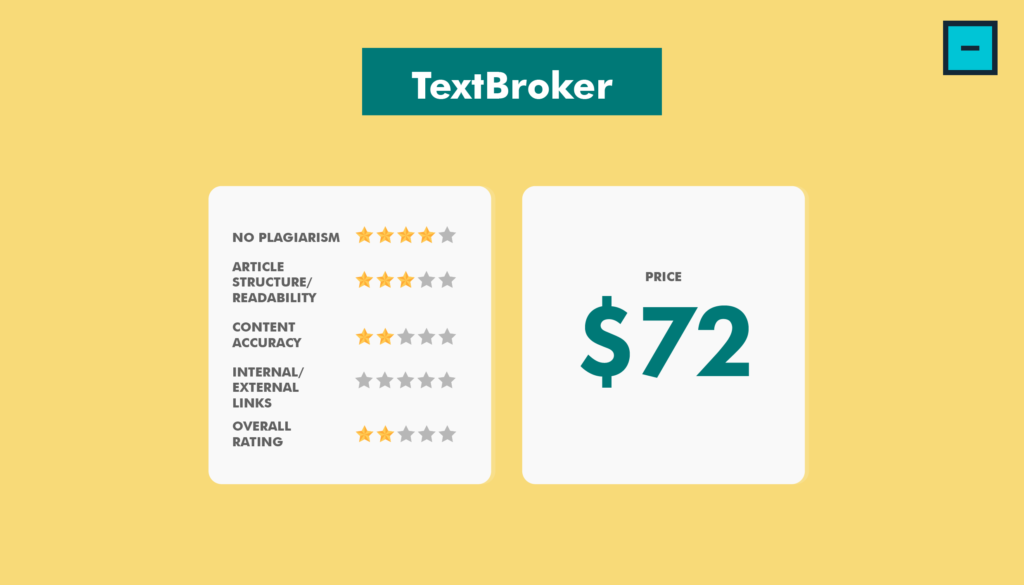
Textbroker’s business model centers on offering high-quality content — simply, quickly, and at a competitive price point.

Their motto is:
“Get Custom Content. It’s fast, affordable and scalable. With the world’s leading digital content platform, you have direct access to thousands of verified US authors.”
They also claim to be the leading article and content writing service on the web:

They offer blog posts, product descriptions, technical content, and more. They also claim that they can “capture your users’ attention and increase search engine ranking.”
Plus, as a content mill, Textbroker packs some serious promises for their prospective client:

Promising content that “breaks the mold” and focuses heavily on SEO optimization is talking a big game. It’s tough to do. And we’re here to put their content creation promises to the test.
Currently, Textbroker lets you choose a freelance writer from over 100,000 verified authors in the United States. What makes Textbroker legit is that they have more than 53,000 returning clients.
That’s a ton of writers and a ton of loyal clients, which is a great sign.
Depending on what content you want, you can order content in up to 15 languages for as little as 1.3 cents per word. That’s a promising proposition for anyone looking to outsource a writing assignment.
Well, we decided to do a Textbroker review. To explore pricing options, we clicked on “I Need Content” at the top of their menu:

This drops down two options:
- Self-Service
- Managed-Service
The managed freelance writing service is a start-to-finish solution for outsourcing all website content. We don’t want that for this test article, so we chose self-service.
Here we are prompted with their offers and pricing section based on author quality rating and service levels:

What’s nice here is that you can see a writing sample of each “Author-Level” . Here is the 5-star example:

Compare that to the writing skills of a 2-star author:

If you want to mess around with pricing for a writing job, they also have a pricing calculator:

So, to get started, we clicked on “Free Client Registration.”

Here we can create our free client account to get started with ordering written content:

Once you create an account, you will get a confirmation message to check your email and confirm the account:

Once confirmed, you get directed to your dashboard:

Here you have a few options. If you want to start ordering written content, you can quickly create a new order:

At the top of our dashboard, if we want to browse authors, we can look through the author search and build a list or team that we like:

We decided to start at the most basic point, at the beginning of the dashboard:

Then, we got prompted again to select our order type:
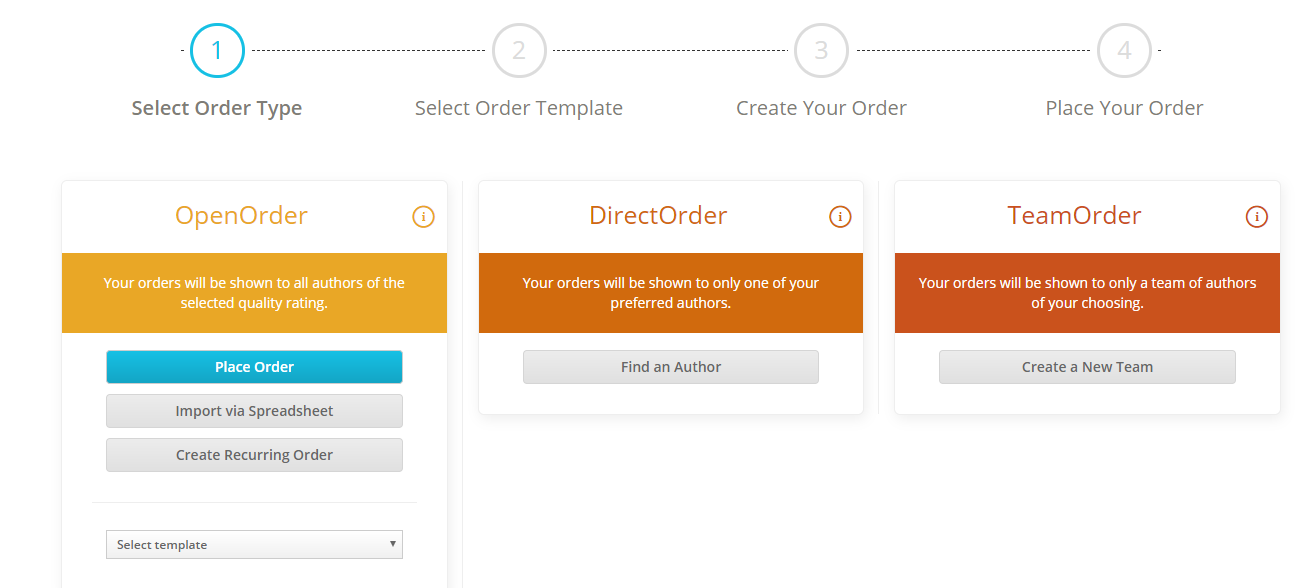
Here we clicked on “Place Order” for the OpenOrder type.

Now you can choose from which template/product type you are looking for:

We decided to go with the “Blog” template and began to fill out order information like word count, quality level, category, blog title, keywords, and instructions:

Repeating the same method for each content farm, we chose the highest level writing at 1,000 words, totaling to $72:

Overall, the process for Textbroker clients is pretty simple. It only takes a few minutes to set up your account, figure out your pay rate, and post an article that you want them to write.
The dynamic pricing tool is excellent for customizing price on the fly without any back-and-forth you usually have with a freelancer or professional writer.
After customizing our order preferences, we were billed just over $72:
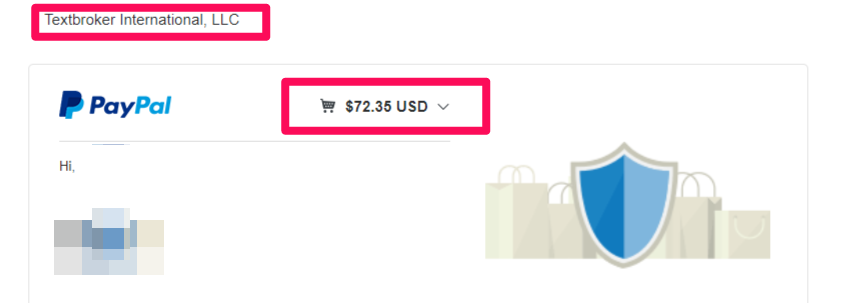
In our orders section, our new project was displayed instantly, a significant benefit that iWriter was struggling with:
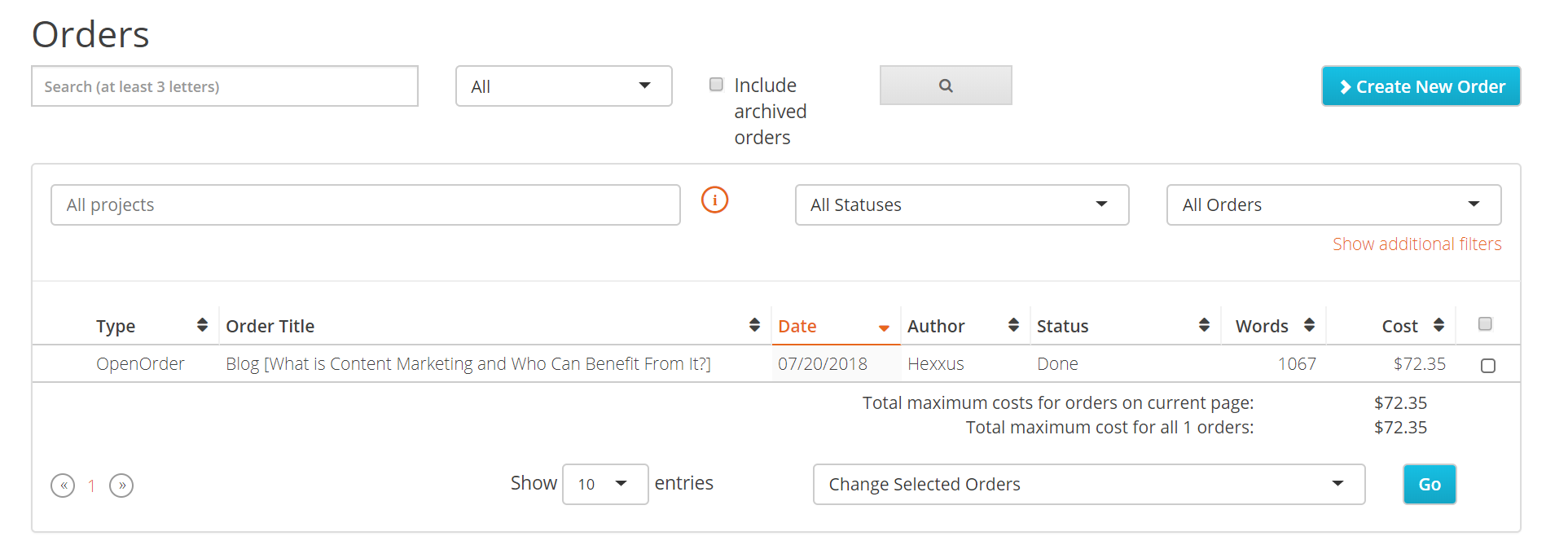
When ready, we just clicked on the order to pull up our piece of content:

So, how did it turn out?
Here’s the finalized article we got sent:
Ready for the breakdown?
- 1,047 words (47 more than requested)
- Cost = $72
- Turnaround time – 4 days
With that information in mind, let’s break it down by the following factors as we did for iWriter:
- Internal links/External links
- Article structure/readability
- Plagiarism
- Content accuracy (is what’s being said actually true?)
First up, internal and external linking.
➁ Internal and External Links
You know the importance of internal and external linking.
But just like iWriter, there isn’t a single link in the entire post.
This is somewhat troubling, especially that there are no external links (at the least). Good quality content needs links and references.
Adding a few external links can help you build credibility in your blog post, and internal links are critical for circulating traffic on your site.
Unfortunately, neither are in this post.
➂ Article Structure/Readability
At first glance, the article structure of the post from Textbroker is much better than iWriter. It flows naturally with a header, intro, H2s, and a clear conclusion.
That’s a great start.
It’s already much easier to digest and skim. If you wanted to, you would barely have to read the post because the subheaders tell you information on what you can expect.
Beyond basic structure, the sentence structure is a bit crowded, but that’s more subjective than objective.
It could use some line breaks to make the reading a bit more smooth:

Moving on, let’s look at the readability.
Plugging the article into Grammarly, the article received a 69 readability score, which is great.
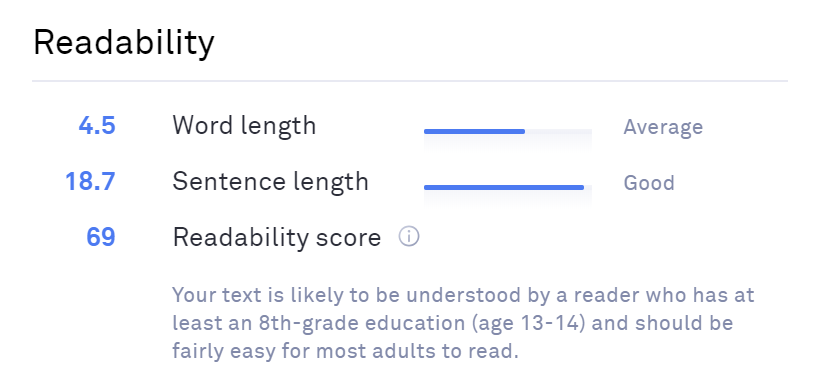
The word length could be improved, however.
This lower score on word length raised a few red flags that I investigated.
Reading the entire post, you’ll start to notice that the tone is very strange, negatively impacting readability.
For example, the following phrases highlighted in red:

These awkward phrases make reading the post slightly harder.
Another example I saw of this (amongst many others) was in the e-book section:

That opening statement is very weird to read. Of course the reader wants another idea about content marketing. That’s the whole point of the post.
This sentence negatively impacts readability and isn’t needed in the first place.
Overall, the structure of the article is solid, but readability could be improved.
➃ Plagiarism
Copying and pasting the article into Grammarly, we noticed that the text returned a 3% match to other online sources, none of which were marketing related:
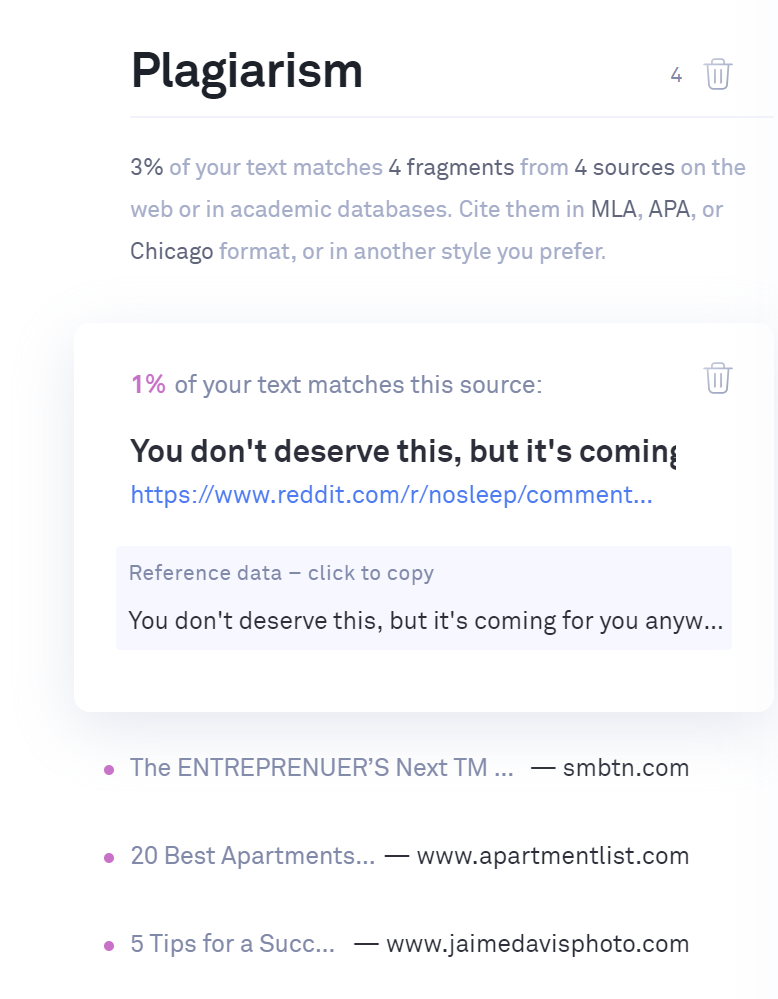
That’s a wonderful thing to see. And essential for content creation these days.
Beyond text-based plagiarism, we analyzed content from around the web on the subject of content marketing, finding that no structure was copied directly from any other articles.
While the tactics mentioned are also used elsewhere, the exact structure of the post and headings appeared originally structured in the Textbroker article.
That’s a win in our book.
➄ Content Accuracy
Reading through the Textbroker piece, we came across a few phrases that were questionable in accuracy/validity.
For example, the section about “Guest Posts.”
In this section, the content writer said:
“In addition to posting content on your own blog, you can also publish content on other blogs in exchange for a link pointing to your website.”
You see, guest posting is a tricky subject nowadays. Five or six years ago, guest posting for links was a viable strategy.
But Google caught on. Even back in 2014, guest blogging was declared to be done.
Sure, you can still get links from a guest post, but if Google finds out that your entire goal of guest posting campaigns is solely for a link, you’ll face serious penalties. Not to mention that byline links aren’t as strong as natural links.
So, seeing this statement in an article about content marketing in 2018 is a bit worrisome. You wouldn’t want to post this on your website as is, as you’d be risking posting false information and misleading your customers.
Plus, more experienced users would look at your post and never return to your site.
A second statement we noticed in the article was a bit flawed in nature:
“The most useful approach is to require your prospects to enter an email address so that you can send them the e-book.”
When talking about e-books, the author of the post said that the most useful approach is using it as a lead magnet in exchange for their email.
Essentially, the author is talking about forms.
But forms aren’t the best converting approach for lead magnets anymore.
In fact, forms are likely dead. Drift proved this with their landmark, year-long study where they generated 15% more new leads, and a faster sales cycle through conversations instead of forms.
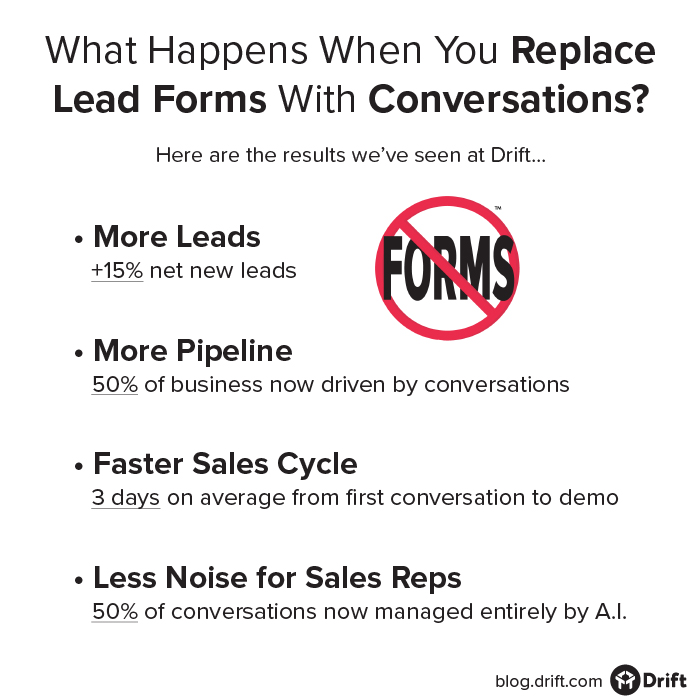
Saying that forms are the best way to use an e-book is not factually correct in 2018.
Instead, we would have liked to see a few ways that the e-book can be used to collect leads, whether it’s forms, live-chat or another tactic.
➅ Expert Opinions: Elisa Gabbert and Benji Hyam
Elisa Gabbert, head of content marketing and SEO at WordStream

1. Who are you?
“I’m the head of content marketing and SEO at WordStream. Our blog gets about 1.5 million visitors a month and drives more than half of our leads.”
2. Ignoring word count alone – Would you publish this piece on your site (yes or no)? Why or why not?
“I would not. From a quick skim, it doesn’t seem that bad at first, but if you actually read it a lot of it is gibberish. Take “If you are looking for a way to grow your business and expand your reach, marketing your content can help.” Or “If you want another idea about marketing your content, consider writing and publishing short e-books.” These sentences make it clear the “writer” doesn’t even have a basic understanding of what content marketing is (it means marketing through content, not the marketing of content!). It basically seems like someone just cut and pasted sentences from other articles and changed a few phrases to make it qualify as ‘unique.'”
3. Why or why not?
“It’s really important to us that people get actual value from our blog, and even if the writing here were edited and polished, the content itself is way too superficial. It’s not actionable and there are no examples. Who would take content marketing advice from a source that’s not good at content marketing?”
Benji Hyam, co-founder of Grow and Convert

1. Who are you?
“I’m the Co-Founder of Grow and Convert – an agency that runs content marketing for companies like Patreon, Leadfeeder, and Inflow. Co-Founder of Wordable.io (Acquired). Previously ran marketing for two VC backed startups.”
2. Ignoring word count alone – Would you publish this piece on your site (yes or no)?
“No”
3. Why or why not?
“The first thing that I notice is that you can tell the freelance writer has no experience in the subject matter they’re writing about. People who write on subjects they don’t know about tend to use filler sentences that state obvious facts, for example: ‘If you are looking for a way to grow your business and expand your reach, marketing your content can help.’
There’s a lot of cheesy statements throughout: ‘The information you discover will arm you with everything you need to move in the right direction, and the outcome will make you smile.’
It doesn’t help the reader accomplish anything. It’s basically a bunch of ideas without a cohesive structure or argument.
There aren’t any real examples in it. Content that comes from subject matter experts reference real examples to help make their argument.
If you’re using this type of content to sell to experienced practitioners, you’ll lose their attention in the first couple of sentences and the content will likely give them a poor perception of your brand instead of a positive one. The quality articles you need to produce need to solve a pain point for the buyer, educate someone (with real experience and examples), and/or entertain them. This article doesn’t meet any of the criteria.”





